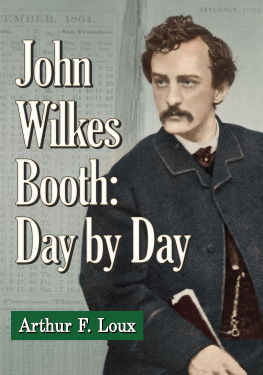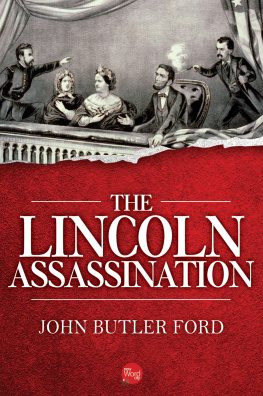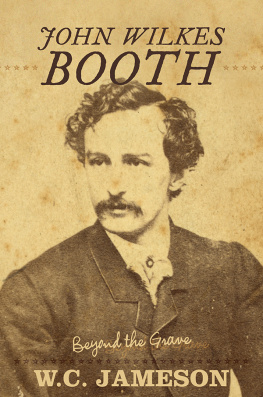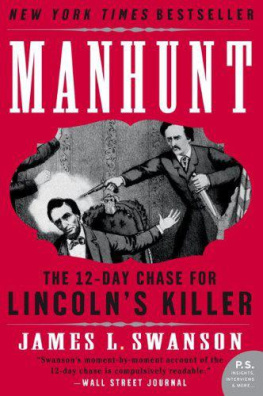
John Wilkes Booth:
Day by Day
ARTHUR F. LOUX

McFarland & Company, Inc., Publishers
Jefferson, North Carolina
Publishers note: Arthur F. Loux died on December 29, 2013, after completing the writing of this book. Special thanks are given to Jennifer R. Loux, who subsequently prepared the manuscript for publication.
LIBRARY OF CONGRESS CATALOGUING DATA ARE AVAILABLE
BRITISH LIBRARY CATALOGUING DATA ARE AVAILABLE
e-ISBN: 978-1-4766-1709-1
2014 Kathleen M. Loux. All rights reserved
No part of this book may be reproduced or transmitted in any form or by any means, electronic or mechanical, including photocopying or recording, or by any information storage and retrieval system, without permission in writing from the publisher.
On the cover: John Wilkes Booth, 1865, Alexander Gardner, photographer to the Army of the Potomac, Washington, D.C.: Philp & Solomons (LIBRARY OF CONGRESS); background: John Wilkes Booth diary page (LIBRARY OF CONGRESS)
McFarland & Company, Inc., Publishers
Box 611, Jefferson, North Carolina 28640
www.mcfarlandpub.com
To
the memory of
John C. Brennan
Acknowledgments
The late John C. Brennan of Laurel, Maryland, provided his wide knowledge of the Lincoln assassination as well as an incredible number of copies of articles, books, and manuscripts. John also introduced me in 1991 to the eventual publisher of this book, McFarland.
The late James O. Hall, unequaled in graciousness and knowledge of the Lincoln assassination, generously provided the benefit of his research, encouragement, and advice.
Lincoln assassination and John Wilkes Booth scholar nonpareil Michael W. Kauffman provided much of his wide-ranging research.
Erik Jendresen contacted me when he was writing the screenplay for the National Geographic film Killing Lincoln. Soon I was happily supplying source documents for various events to satisfy Eriks dedication to historical accuracy. That effort re-generated my enthusiasm for completing this book.
I am most grateful to Jennifer R. Loux, a historian by profession, who brought her considerable editing talents, organizational skills, and eagle eye to bear on my manuscript, which was started about the same time as she was born. While I take full responsibility for this work, it is much improved by her efforts.
The knowledge and assistance of many Booth buffs and Lincoln assassination experts contributed to this book. Among them are: Bob Allen, Terry Alford, the late Louise Mudd Arehart, Randal Berry, Joan Chaconas, Jeannine Clarke Dodels, the late Dinah Faber, Joseph George, Jr., Nancy Griffith, Richard and Kellie Gutman, William Hanchett, the late Constance Head, Frank Hebblethwaite, the late Rev. Alfred Isacsson, the late Rev. Robert Keesler, Arthur Kincaid, Deirdre Kincaid, the late Dr. John K. Lattimer, the late Ernest Miller, Steven G. Miller, Roger Norton, Betty Ownsbey, the late Bert Sheldon, Richard E. Sloan, Angela Smythe, John Stanton, Louise Taper, Dave Taylor, Laurie Verge, and Sandra Walia.
Others who provided assistance are: Herb Adams, Steve Archer, the late Jack Brown, Tim Daniels, the late Donald Dow, the late Howard and Dorothy Fox (proprietors of Tudor Hall), Randall Haines, Roger Hunt, Dale Jirik, George Kackley, the late Franklyn Lenthall, E.A. Bud Livingston, Vicki Lockhart, Robert C. Marcotte, Mrs. Jean Struthers Newell, Judy and William Newell, and Gerald Trueson.
My wife, Kathleen, planned research trips, assisted in library research, and performed many services which propelled the completion of this book. Thanks also are due our children, Jennifer and Lauren, who spent parts of many spring and summer vacations touring Booth sites, cemeteries, and libraries.
A.F.L.
Preface
On a memorable day in 1977, I was among a busload of people on the first Surratt Society Booth Escape Route tour. James O. Hall, a mellifluous-voiced, white-haired man who immediately commanded respect, guided the tour. I met John C. Brennan, an energetic force of nature, and Mike Kauffman, a young man who seemed to be as knowledgeable about the people and events surrounding the assassination as Mr. Hall. I met Richard Sloan, Laurie Verge, Joan Chaconas, Nancy Griffith, Betty Ownsbey, and Louise Arehart (a granddaughter of Dr. Samuel A. Mudd). At Port Royal, Virginia, the group visited Maude Motley, who described how she had obtained the piece of John Wilkes Booths crutch she cradled in her hands. For a historian, days dont get much better than that.
Several days after the tour I found my mailbox jammed with letters from John Brennan. I was hooked. My mailbox remained full for many years with correspondence from Brennan and others who were researching every possible aspect of the Lincoln assassination. I began to record information about Booth in a day-by-day format by typewriter and on the computers of the day. I scoured libraries and museums. I visited the cities where Booth performed and the region where he prospected for oil. In 1990 I self-published twelve copies of John Wilkes Booth: Day by Day. I considered this to be a preliminary version that would be useful to my fellow researchers while I completed a more thorough rendition.
In the years after the initial publication, John Wilkes Booth: Day by Day has been cited in virtually all serious books and dissertations about Booth and the Lincoln assassination. With varying degrees of frequency, an email or phone call would bring a request for a copy of the book. A number of great friendships developed from these contacts.
Each page of the first edition of Day by Day was in the format of a weekly calendar from Sunday to Saturday. When I could identify an activity or event in the life of John Wilkes Booth, I made an entry in the appropriate date. Days and even weeks were blank when no information was available. On the other hand, there was such a wealth of information for some days that important material had to be severely abbreviated or left out because of limited space. Another deficiency of the format was difficulty in presenting certain findings that could not be assigned a specific date. In this new edition, the one-week-per-page format has been abandoned, allowing as many entries per day as necessary. Each entry notes the city in which Booth ended the day (when known), followed by his activities on that date. Information not specifically about Booth but which is considered pertinent closes the entry. A narrative, necessary to tie together and make sense of what was happening, begins each chapter.
Sparse information survives about John Wilkes Booths youth. I have included notices of his fathers theatrical appearances in his home city of Baltimore to indicate the frequency of his being home, where his presence influenced his sons development. I have traced Booths acting career through newspapers, advertisements, reviews, and personal accounts of observers. I have included many reviews verbatim to allow the reader to form an opinion of Booth as an actor. In the day-by-day entries, reviews appear on the date of the performance rather than on the date they were published.
In examining the sources, those closest to the event receive the most credence. Sources far removedfor example, recollections in a newspaper article fifty years laterare given little or no credit, unless they are corroborated. In several instances, rather than ignore what I judge to be prejudiced or inaccurate accounts, I include them with commentary so as to allow the reader to form an independent opinion.
Next page







